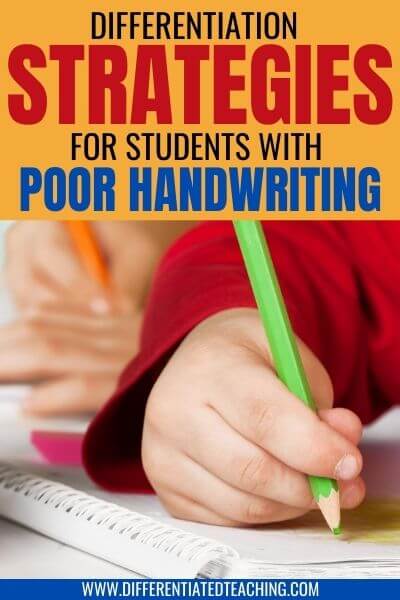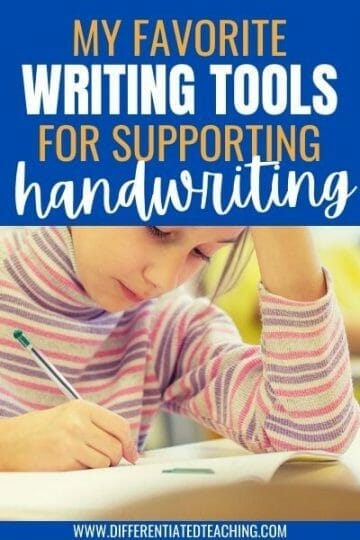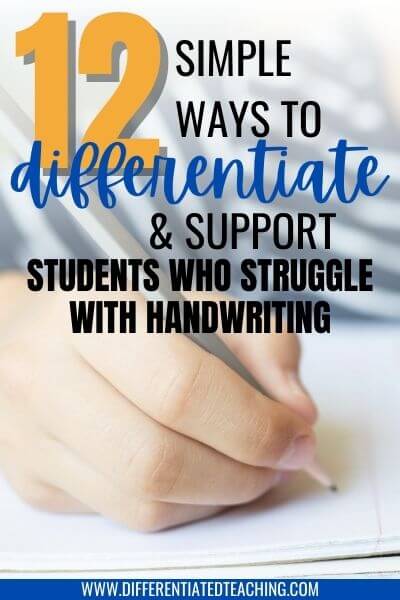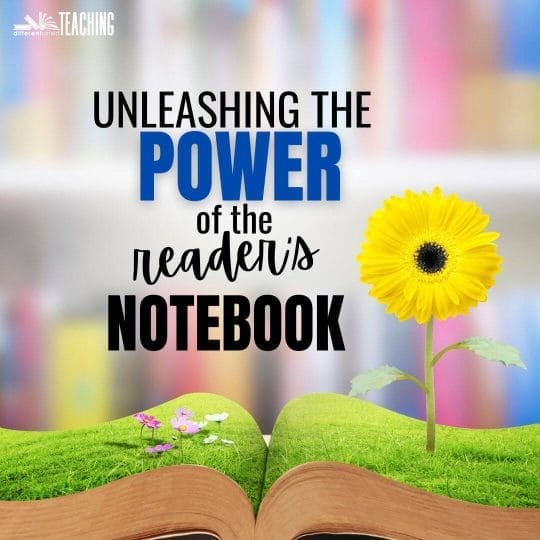12 Ways to Differentiate for Students who Struggle with Handwriting
Handwriting is taught at an early age in most schools. However, with so many standards to teach, it is often a quick and cursory process. This makes it easy to understand how some learners never have a chance to develop their handwriting skills to automaticity.
Unfortunately, few schools provide interventions in this area for 1st & 2nd graders. As a result, these children often continue to struggle with legibility. This can impact both their academic performance and self-esteem through elementary and middle school. These academic difficulties then unnecessarily continue to carry with them through the remainder of their schooling.
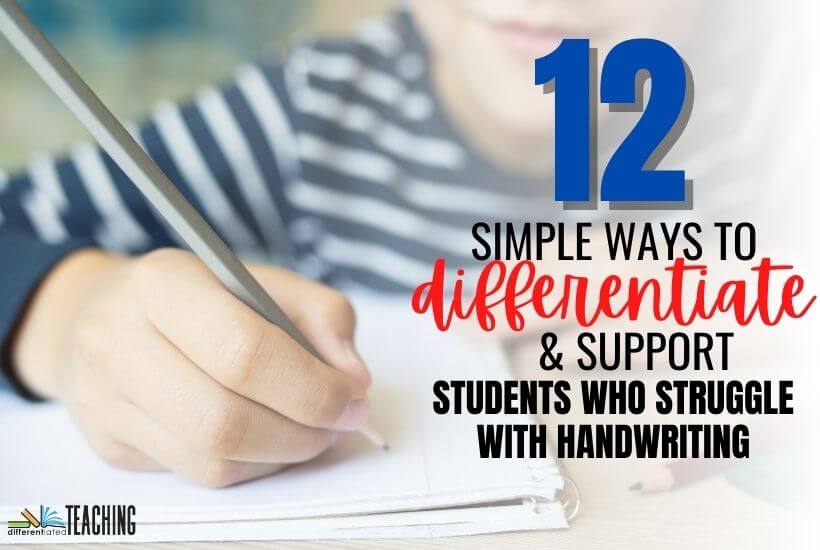
However, there are strategies that can help these learners avoid the frustration and overwhelm that come with handwriting difficulties. In this blog post, we’ll explore five ways you can differentiate and support students who struggle with handwriting.
This post contains affiliate links. Purchases made through this link don’t cost you anything additional, but I receive a small commission. That being said, I only recommend products that I truly feel are high quality and best for kids!
Recognizing handwriting issues in elementary students
See if this student sounds familiar. When Larry starts writing, he is eager to share his ideas. However, as he finishes those first words, he struggles to recall the rest of the sentence he has just begun. Kids like Larry have ideas. However, they struggle with writing because handwriting is so laborious. Their poor handwriting skills interfere with their ability to share all the ideas going on in their heads!
Those learners who persist often create very short compositions that are very challenging to read due to legibility issues. In fact, many times the student cannot even re-read their own writing because of their poor penmanship.
We often recognize these students in the first days of school because they lack fine motor coordination. A few may be receiving occupational therapy, but I’ve found is the minority vs. the majority.
I bet you instantly recognized this profile, right? There are a few kids like this in nearly every elementary classroom.
Since the goal of writing is to express ideas in a way that can be understood by the reader, difficulty with handwriting can drastically impact school performance and their ability to enjoy the writing process. For many of these learners, handwriting is a physically uncomfortable, if not painful, process.
Commonly observed characteristics of handwriting struggles:
You’ll likely have some students in your classroom that actually struggle with the process of getting their thoughts on paper legibly. These pupils are typically noticeable from the early days of the school year.
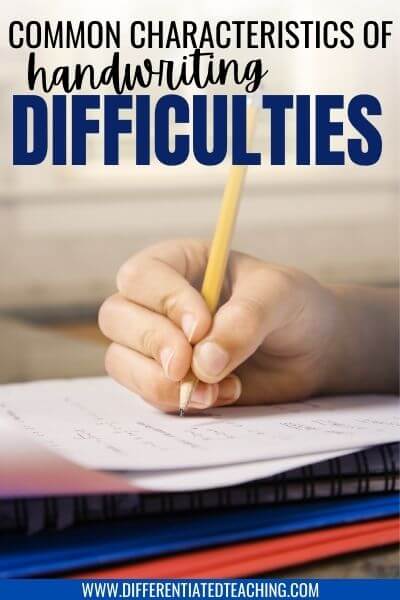
Here are some things you might notice when observing students with poor handwriting skills:
- Usual pencil grip or body positioning for writing
- Easily fatigued during writing tasks – often stopping to shake out their hand, etc.
- Poor letter formation
- Inconsistent spacing between letters/words
- Unclear word boundaries or difficulties with margins
- Inconsistent letter-size or difficulties staying within the lines
- Excessive erasing or rewriting
If you notice any of these things happening with a student in your classroom, then chances are the learner is having trouble with the physical act of writing. This is especially true once students reach 2nd-3rd grade, where these difficulties become less prevalent.
Strategies to Help Students Who Struggle with Poor Handwriting Skills
Before we diving in with the instructional strategies, it is important to note that all of the above can be signs of a learning disability called dysgraphia.
You should also be collecting data and work samples while implementing the strategies below. Then bring the child to your campus student-support team to discuss more formalized interventions. You can also consider the benefits of consulting with your campus OT.
In the meantime, there are a number of ways to differentiate instruction to better support these learners both during your writing block and throughout the school day. Today I’ll share some easy ways you can get started.
1. Offer extended time or modified length on writing tasks.
Handwriting can be a physically demanding process for these students, and it often takes them significantly longer than peers to complete even simple writing tasks.
Purposefully building in extra time for writing or reducing the length of the task to align with the time available can be an easy way to help reduce their frustration when peers are finishing and they aren’t.

2. Teach keyboarding skills and allow students to type when possible.
Typing has been shown to improve both academic achievement and self-efficacy among struggling writers. A strong foundation in touch-typing, or typing without looking at the keyboard, speeds up assignment completion tremendously. It also becomes easier for students to get their ideas on the page.
There are a number of free online tools that can be great for developing these skills including:

Alternatively, Touch-Type Read & Spell (or TTRS) is an evidence-based resource. While it is a paid program, it is great! It helps build typing skills while supporting the development of reading and writing skills. The multisensory approach makes it great for students with dyslexia, too. It was one of my daughter’s favorites while we homeschooled last year.
Ready to try Touch-Type Read Spell? Enter code RDAVIES check out for a 10% discount.
An added bonus is that developing typing proficiency at an early age actually offers these learners an advantage in later years when typing will be their primary mode of written communication and required for most assignments.
3. Offer low-pressure opportunities to practice and improve letter formation.
Many students with poor penmanship don’t enjoy writing because they are embarrassed by their bad handwriting. However, old-school handwriting practice is boring and without teacher supervision, modeling and support they just reinforce bad habits.
That being said, there are many great, low-cost handwriting apps available. Many have built-in modeling and feedback. This helps students work on these skills in a way that is fun and engaging.
These can be done on tablets using an inexpensive stylus. I preferred to offer the apps as a choice during your classroom’s Tier 1 intervention time
Here are a few examples of my favorite apps for practicing handwriting tasks for the iPad:
I’ve shared many more in my blog post about the handwriting apps we’re using with my daughter.
4. Differentiate the writing paper you provide to students.
Providing alternative writing papers can be another helpful way to support students who struggle with handwriting. Offering papers that provide multi-sensory cues can be a great way to help learners manage handwriting expectations during in-class assignments. I’ve used these with success both in the classroom and while homeschooling my daughters to help them better attend to letter sizing and formation.

Here are a few of my favorites:
- Hi-Write Paper: This paper uses the traditional 3-line format for beginning writers, but the lower half is a bright yellow to provide a visual cue for letter formation.
- Quick & Neat Writing Pad: This paper is great for those who have difficulties with boundaries and sizing for letters. You’ll want to introduce how to use the boxes, but it can make a huge difference for 2nd-3rd graders who struggle with spacing. (This company also offers specialized paper for math computation, which is great for helping students line up numbers.)
- See & Feel Paper: This one was a game-changer for our oldest. The multisensory format includes raised lines so that students physically feel the upper and lower boundaries for letters. This can be a cue to help them keep letter sizing more consistent.
- Legiliners: These are great for adding lines to worksheets or other tasks where the writing space isn’t neatly organized. For example, if students are expected to write a sentence to go with an illustration, this can be a great tool. We’ve got them in all the available sizes.

It is crucial to introduce the paper and how to use it. Illegible handwriting can be improved, but only if students understand how to use the embedded multisensory cues.
Also, you may want to offer several options or do a trial period with different paper types to find out which works best for your learners. In the classroom, some learners with writing difficulties can be very sensitive to using paper that looks different than peers so you’ll want to make sure to include the student in the decision-making process.
5. Differentiate the writing utensils to help with handwriting issues.
Offering alternative writing tools can also help students who have poor handwriting. Again, this can take some trial and error. However, it is a good way to ensure that they find the right fit for their needs and personal comfort.
In the last year, we went through many different options with our own kiddo! It was a process to find the best tools to help her as she worked to develop the fine motor skills to write legibly.
Here are a few suggestions we found helpful:
- Triangular pencils: These mechanical pencils are great if the issue is manual dexterity. The triangular shape is perfect for gripping, and they are slightly fatter than traditional pencils which makes a big difference. However, they aren’t ideal for kiddos who tends to put too much pressure because the lead breaks often.
- Half-pencils: This is another game-changer for us. The smaller pencils were recommended by our OT to help encourage correct pencil grip and more control. These are a HUGE help for making writing more legible.
- Pencil grips: There are so many of these available that you may have to do some trial and error to find the right one. Most occupational therapists have a variety of options. Many will be happy to lend you.
Many students do better with pens or even writing on whiteboards. I shared the options that worked for us, but you will need to spend time finding what works for you.
6. Provide notes or offer fill-in-the-blank versions.
When writing is laborious, students struggle to keep up with in-class notetaking. Offering structured notes can help. Structured notes mean they only need to fill in key terms vs. starting with a blank slate. They are great for supporting executive functioning skills, as well.
Pre-typed notes can also encourage students to attend to lesson content rather than trying to keep up with notetaking.
Alternatively, you can also get a copy of notes from a peer. Photocopy them for the student to keep in their journal or folder.
7. Consider allowing oral response or utilize a scribe when appropriate.
This is, of course, a fine line until students are clearly identified as qualifying for special education services. Although it shouldn’t be an issue, it is important to document when you offer the opportunity for oral response.
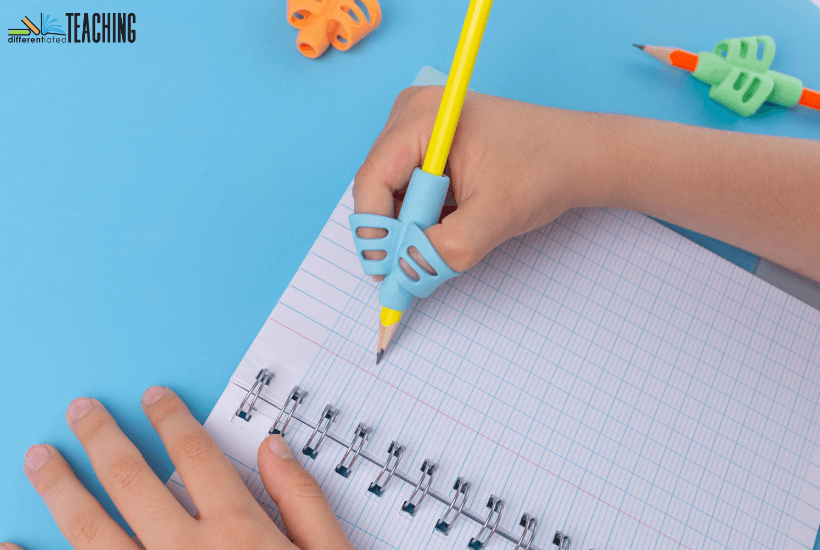
If you’re collecting data for a pre-referral intervention, you might even allow the student to provide their answer orally after they write their response to show the difference between the level of understanding the student can communicate orally vs. what they can share in writing.
Once you’ve collected a writing sample like this once or twice, you should have plenty of data to support your concerns and can feel confident that you’ve created the documentation needed to support the use of this differentiation strategy if questioned.
In addition, a scribe can be helpful for keeping bubble sheets neat and organized when it comes to standardized assessments.
8. Consider the use of dictation software.
When students are first learning to type, the process can be slow and just as painstaking as physically writing. Instead of forcing these learners to suffer through it, dictation software can be a great tool for capturing ideas and getting the initial ideas out on paper so the student can go back and refine their writing or revise with the class.
When using dictation software, you’ll want to find a quiet place where they can verbally tell their stories and have the computer type for them.
Why consider dictation software..isn’t that cheating?
Since the goal is the cognitive process of creating a cohesive composition, beginning orally is a reasonable accommodation. Dictation software can help remove the barriers to getting ideas on paper and reduce the stress on overworked hands. It is also a great tool to help students overcome avoidance of writing if they’ve struggled unsuccessfully for several years.
This option is built into Google Docs. You can also get specialized software that can be used across different computer-based programs.
Personally, we’ve had great experiences with Dragon software, formerly called Dragon Speak Naturally, with our daughter with a speech impairment and fine motor issues. It does a good job of learning over time, which is helpful when the spoken language isn’t always perfectly clear.
9. Teach cursive handwriting skills as an alternative to print.
This may seem counter-intuitive for students who are already struggling with handwriting, but there is a strong body of research that supports the transition to cursive for these learners.
Here are a few of the benefits of teaching cursive:
- provides opportunities for developing spatial awareness and supports motor planning
- letter formation leads to fewer errors or letter reversals
- helps strengthen connections between areas of the brain for reading and writing
- supports & builds muscles necessary for penmanship
- can prevent problems with uneven letter spacing or sizing
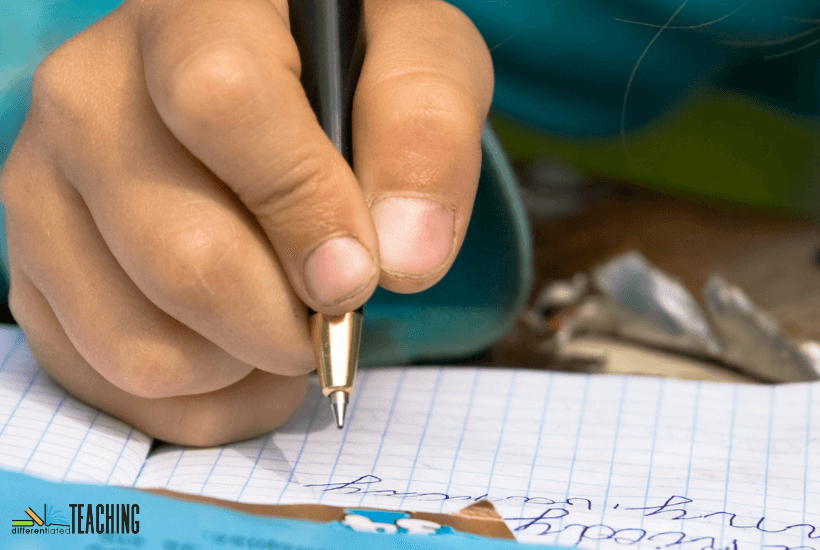
While it may not fix poor handwriting completely, cursive often results in improved handwriting skills. Handwriting Without Tears is one easy-to-implement program. It can be a great way to introduce cursive without adding stress to your plate. Many learners find the program is actually an enjoyable handwriting task.
10. Offer a letter strip for the student’s desk.
Many times students who struggle with handwriting struggle to visualize the letters they are preparing to write. This means they are spending their cognitive resources trying to recall what the letter looks like and how to make it rather than sharing their ideas.
An easy way to reduce this interference is by giving the student a readily available model through the use of an alphabet strip. If you’ve got time, you can even have them create their own alphabet strip by modeling and having them recreate each letter formation
Just remember that this can be another area that you’ll want to discuss with older students. Many times they can be uncomfortable with looking different from peers and may prefer their alphabet strip be kept inside a folder or binder rather than on display.
11. Provide material at the student’s desk vs. requiring them to copy from the board.
Copying from the board is a challenging task for many struggling writers, especially those with dysgraphia and dyslexia. Although it may seem like a straightforward skill, students must simultaneously use several skillsets.
First, they need to be able to create and hold onto the mental image of each letter or number they need to write and apply that image as they write. In addition, copying information also uses short-term memory stores to hold information until they write it down on paper. Finally, they need to apply their graphomotor skills to form the letters in a legible fashion.

For struggling writers, this is a lot of work! It’s no wonder this often results in messy handwriting or missed information. These challenges are only compounded when students have other conditions like Attention Deficit Hyperactivity Disorder!
Providing the student with a handout of the material to keep in front of them while they transcribe helps reduce this cognitive load.
12. Reduce unnecessary writing steps.
For many struggling writers, fatigue is a real issue. This means that every stroke they make or word they write is drawing from a limited tank. You can preserve writing stamina by providing students with sheets that are already labeled with their name or heading. They will be able to get more on the page when this is not the first thing they do.
Similarly, providing sentence stems can be a helpful strategy because it helps keep the student focused on writing the information that really matters for you to assess their understanding.
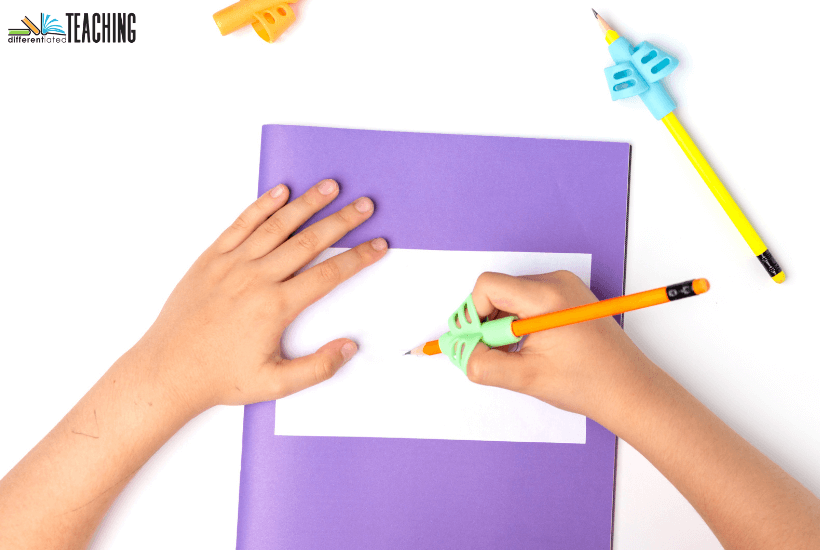
Do not let poor handwriting be a barrier to academic success.
Handwriting is an essential skill for students. It helps them communicate effectively and efficiently. However, handwriting is also a very complex skill that many struggle with.
If you are a teacher, you know that there are many different reasons why students struggle with handwriting. Some simply lack the ability to write legibly. Others struggle because their handwriting is illegible. Still, others struggle because they have poor fine motor skills.
The most important thing we can do for these students is to find ways that keep handwriting from being a barrier to sharing their understanding. The 12 strategies shared above are just a few ways you can work to support those who struggle with handwriting, but there are many more that can also be helpful.
Document the Tier 1 supports you’re giving and their outcomes so that you can effectively advocate for your learner’s needs during a Student Support Team meeting and provide input if the learner is later identified as having a learning disability.

